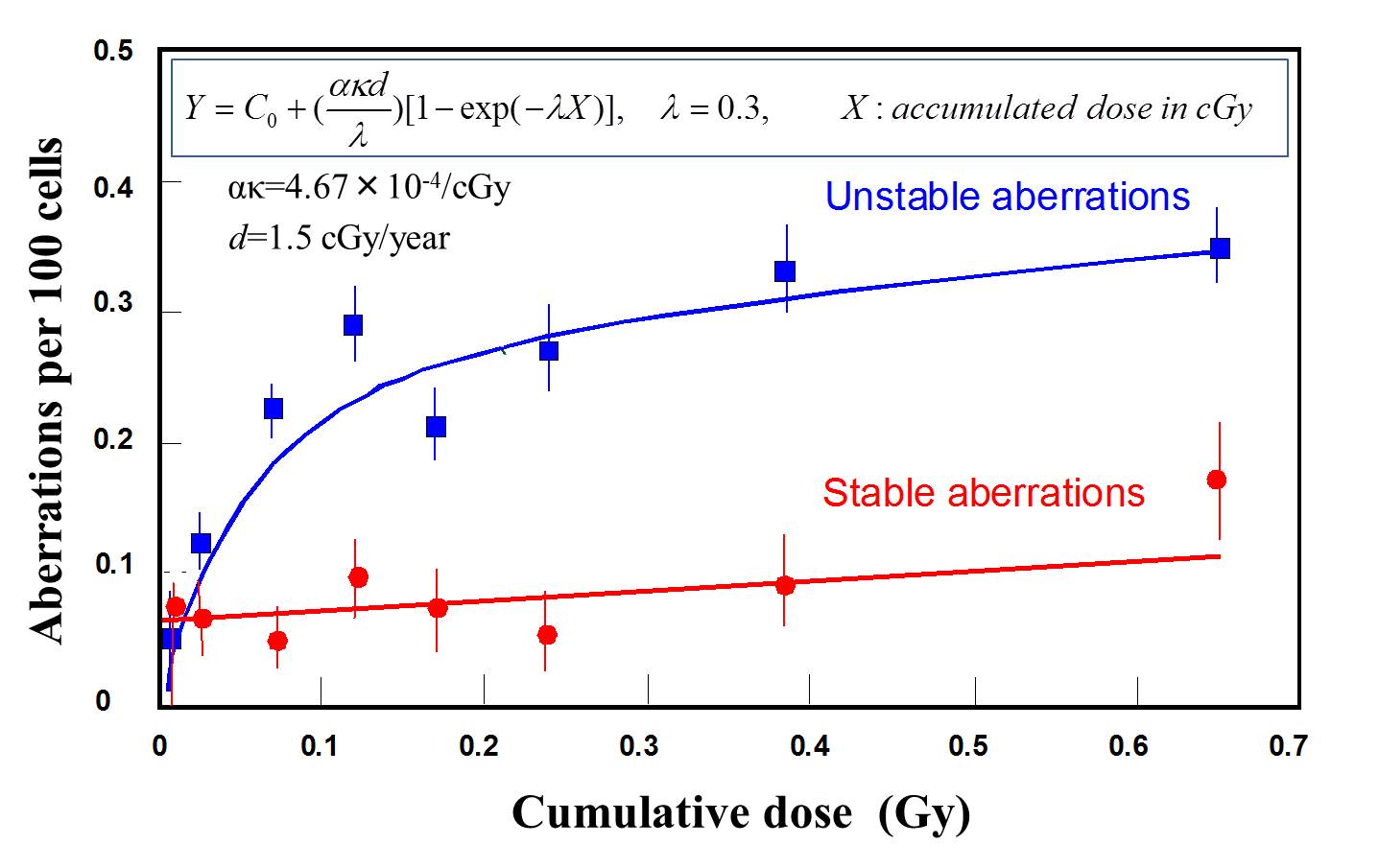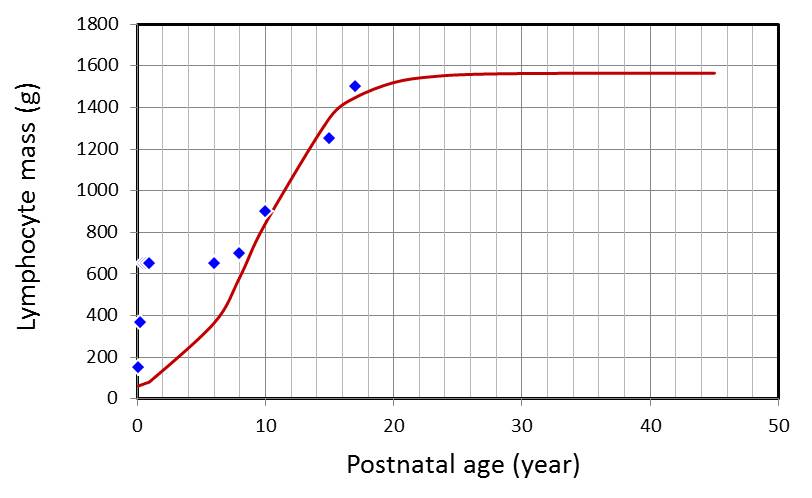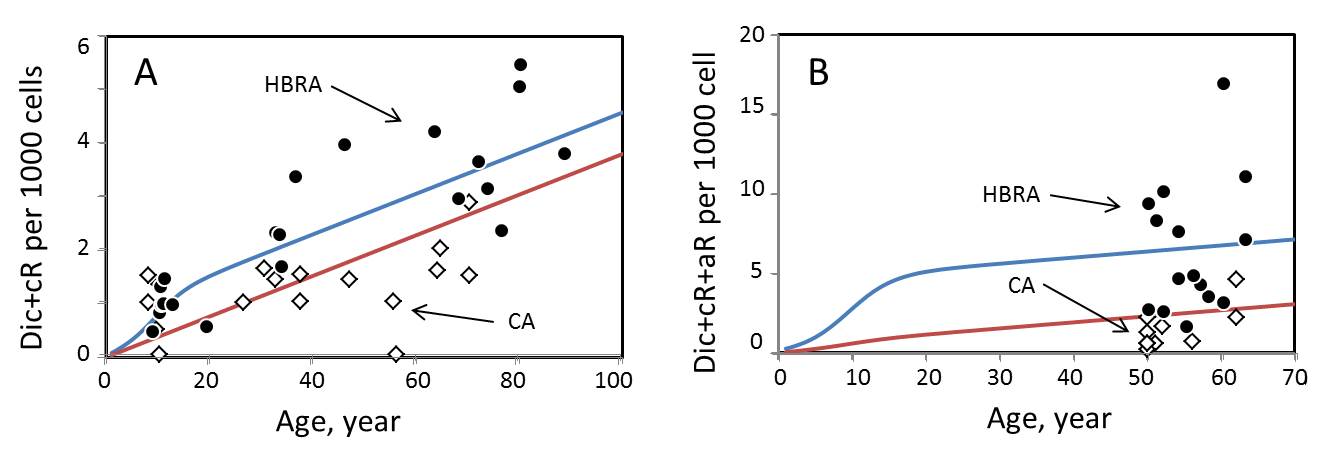Fig. 1. Frequencies of chromosome aberrations in the radiological technologists (occupational exposure). (Sasaki 1988)

| Commentary: Dose-response kinetics at low dose-rate |
[1] General model (Ref: Sasaki, M. S., Berzelius
Symposium XV, Umea, pp.131-140, 1988)
At a given time, t, in steady state of
lymphocyte homeostasis, it is assumed that the lymphocytes are to be eliminated
at a rate S=exp(-λt) with a mean lymphocyte lifetime of 1/λ,
and the lost fraction is supplemented by newly formed lymphocytes. If the
aberrations are of the unstable-type, they will be lost according to lymphocyte
turnover rate. Thus, during chronic radiation exposure at low dose-rate, the
level of unstable chromosome aberrations of interest is in a balance between induction
by radiation and reduction by lymphocyte survival.
Given ‘ακd‘ an increment of chromosome
aberrations at dose, d, and κ being
dose modification factor, the following dynamism may be involved to determine
chromosome aberration frequencies in peripheral blood lymphocytes, i. e.;
(a)
Loss of aberrations due to lymphocyte lifetime: U/U0=exp(-λt)
(b)
Differential at a given time: ∂U/∂t=ακd-λU
(c)
Integrated yield from time 0 to t of
exposure being given by
Y-Y0=(ακd/λ)[1-exp(-λt)], . . . . . . . . . . . . . . . . . . . . . . . . . . .. . . . . . .
. . (1)
in
a function of time of exposure, t, or
Y-Y0=(ακd/λ)[1-exp(-λT/d), . . . . . . . . . . . . . . . . . . . . . . . . . . . . . . . . . .
(2)
in
a function of accumulated dose, T,
where
λ=0.3 or mean lifetime of 1/λ years (about 1200 days). Y0 is spontaneous frequency. It is age dependent as
expressed by Y0=3.80×10-5/cell/age
(y) for the unstable aberrations in normal healthy Japanese (Tonomura et al
1983).
(d)
Since cells with only stable-type aberrations can go through cell division, the
stable aberrations can be inherited by daughter cells, and hence may not be
lost but only when they are not associated with unstable aberrations. And thus
their frequencies are expected to increase in propotion to the dose
accumulation, i.e., S-S0=αsκdt.
The following is an example showing stable- and unstable-type aberration
against accumulated dose in occupational chronic exposure (radiological
technologists). Unstable aberrations increase with the accumulation of
dose following the dose-response predicted in Eq-1. In contrast, unexpectedly,
stable aberrations are refractory to radiation dose (Sasaki, 1988).
|
Fig. 1. Frequencies of chromosome aberrations in the radiological technologists (occupational exposure). (Sasaki 1988) |
 |
[2] Lifetime exposure (Age-dependency model)
In the case of lifetime exposure, like in the residents of high natural background radiation area (HBRA), such a loss-and-gain balance of lymphocyte population does not hold particularly in the early stages of development. The newly produced, unstable aberration-free, lymphocytes rapidly dilute the aberration-bearing old lymphocytes as if they shorten the mean lifetime of lymphocytes. Therefore, the mean effective lymphocyte lifetime might change depending on postnatal age (X) because of more
active production of lymphocytes than their loss during the early stages of
postnatal life. This dilution effect is analogous to the changes in aberration
frequencies by replenishment of lymphocytes after radiotherapy.
The dilution effect was simulated by age dependence
of lymphocyte mass (ICRP 1975 Report No. 23, Reference Man). They are total
lymphocytes (lymphocytes of red marrow, spleen, lymphnodes, blood, outside
hematopoietic tissues). The age dependency was expressed in a logistic
function of postnatal age. The lymphocytes show very rapid expansion in
early infancy (<0.5 year), which is followed by much slower growth until
adulthood (Fig. 2).
| Fig. 2. Postnatal changes of total lymphocyte weight (ICRP 1975) and fitting to the logistic model, K/[1+b∙exp(-a∙X)]. Rapid expansion at age <0.5 year was not considered in the curve fitting, because this explosive growth was followed by a steady differentition stage. |
 |
However, for the simplicity, the postnatal
growth was fitted to a logistic function of age assuming smooth increase.
Y=K/[1+b∙exp(-a∙X)]
. . . . . . . . . . . . . . . . . . . . . . . . . . . . . . (3)
Assuming
proportionality between effective lymphocyte lifetime and lymphocyte mass, we
obtain the age-dependent effective turnover rate of lymphocyte lifetime as
Λ=λ[1+b∙exp(-a∙X)],
. . . . . . . . . . . . . . . . . . . . . . . . . . . . . . (4)
In
which λ is turnover rate in adults (λ=0.3), X is postnatal age in year. The
parameters of the best fit are a=0.3365 and b=24.7425.
The
frequency of unstable aberrations after lifetime exposure at age X is given by:
Y=Y0+(αkd/Λ)[1-exp(-ΛX)], . . . . . . . . . . . . . . . . . . . . . . . . . (5)
The
induction rate of α=(2.117±1.817)×10-4/cell/cGy was adopted for
dicentrics as an average of 19 laboratories for 60Co and 137Cs
gamma-rays.
Fit to the aberration data of Yangjiang, China, and Ramsar, Iran, are shown in the followings (Fig. 3). Fitting is rather poor for control area (CA) in Yangjiang, China. The dose modification factor, κ, may reflect varying conditions of the exposure state, such as external dose vs internal dose inclusive, relative biological effectiveness etc, of radiation concerned. And, the modeling itself is also the subject remained to be justified.
| Fig. 3. The present age-dependency model was fitted to the chromosome aberration data in Yangjiang, China (Jiang et al., J. Radiat. Res., 41(suppl):63-68, 2000), and Ramsar, Iran (Zakeri et al., Radiat. Environ. Biophys., 50:571-578, 2011). |  |
| Parameters of the best fit | ||||||
| Parameters | Yangjiang, China | Ramsar, Iran | ||||
| HBRA | CA | HBRA | CA | |||
| Aberration type | Dic+cR | Dic+cR | Dic+cR+aR | Dic+cR+aR | ||
| Average dose rate, d (cGy/y) | 0.370 | 0.070 | 0.596 | 0.194 | ||
| Dose modification factor, κ | 3.31 | - | 11.8 | 0.95 | ||
References
Sasaki,
M. S. (1988): Chromosomal approaches to the dose assessment in human exposures
to ionizing radiation. Berzelius Symposium XV, pp.131-140.
Tonomura,
A., Kishi, K. and Saito, F. (1983): Types and frequencies of chromosome
aberrations in peripheral lymphocytes of general populations. In: Ishihara, T. and
Sasaki, M. S. eds., Radiation-induced Chromosome Damage in Man. Alan R. Liss,
Inc., New York, pp.605-616.
ICRP
Publication No. 23. (1975): Report of the task group on reference man.
International Commission on Radiological Protection. Pergamon Press, Oxford,
New York, Toronto, Sydney, Braunschweig.
M.
S. Sasaki (Professor Emeritus, Kyoto University)
masao.sasaki.43n@st.kyoto-u.ac.jp